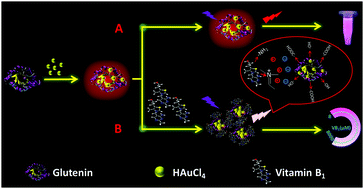Various nanoclusters have been conceived to sense different targets by virtue of their promising fluorescence signals. Herein, glutenin-directed gold nanoclusters (AuNCs@Glu) with red fluorescence have been synthesized. Meaningfully, the nanoclusters exhibited multiple advantages, including favorable photostability, low toxicity and stability. The –COOH, –NH2, –OH, and –C![[double bond, length as m-dash]](http://www.rsc.org/images/entities/char_e001.gif) O groups on the surfaces of AuNCs@Glu facilitate possible applications of the nanoclusters towards sensing. Thus, the abundant carboxyl and hydroxyl groups of AuNCs@Glu enable vitamin B1 to be adsorbed on the surface, leading to obvious fluorescence quenching through emerging aggregation. On the basis of this phenomenon, AuNCs@Glu were applied for detecting Vitamin B1; they achieved a linear range of 8 to 8000 μm with a detection limit of 115 nM, which broadens the avenues of assaying vitamin B1.
O groups on the surfaces of AuNCs@Glu facilitate possible applications of the nanoclusters towards sensing. Thus, the abundant carboxyl and hydroxyl groups of AuNCs@Glu enable vitamin B1 to be adsorbed on the surface, leading to obvious fluorescence quenching through emerging aggregation. On the basis of this phenomenon, AuNCs@Glu were applied for detecting Vitamin B1; they achieved a linear range of 8 to 8000 μm with a detection limit of 115 nM, which broadens the avenues of assaying vitamin B1.

